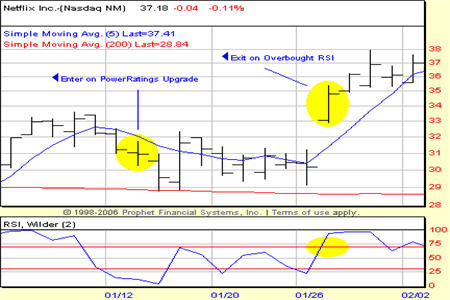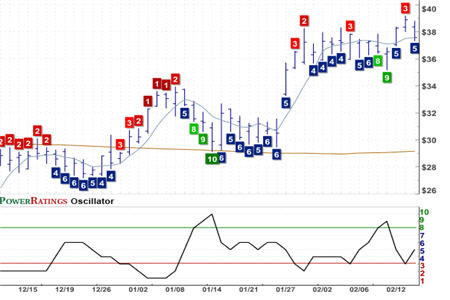PowerRatings, Exits and Profit-Taking
For today, I wanted to look at some of the strategies for exiting trades that PowerRatings traders can use to help maximize their trades. Keeping in mind our general trading strategy of buying low and selling high, our exit strategies are geared toward ensuring that we are selling/exiting our positions when the stocks or ETFs we have positions in are in demand. This is one way to ensure that you are getting the best possible price – by selling to willing buyers.
In each case for today’s examples, we will use the Short Term PowerRatings upgrade of Netflix
(
NFLX |
Quote |
Chart |
News |
PowerRating) from 8 to 9 as our buying signal. Netflix, in the past few months, has twice had its Short Term PowerRating upgraded to 9 (and higher) from 8, and both instances serve as good examples of how our exit strategies work.
NFLX earned a Short Term PowerRating upgrade from 8 to 9 on January 13 with a closing price of 30.94. The stock had not only just earned a significant PowerRating upgrade, but had moved even deeper into oversold territory with its 2-period RSI dropping to below 11.
So let’s say we are long NFLX at 30.94 or so on January 13th. How do we know when to get out?
The first exit strategy is a very simple and straightforward one. After we have taken a position, we look to exit the trade on a close above the 5-day moving average. Because we bought the stock when it was weak — NFLX had pulled back from a recent high of about 33.58 — we would be looking to sell the stock into strength and a close above a short term moving average like the 5-day is just one sign of that kind of short term demand that we need.

The second exit strategy involves using the 2-period RSI. In the same way that we like to buy on weakness and sell into strength, we also like to buy oversold stocks and ETF and sell overbought ones. This strategy means we can use the overbought levels in the 2-period RSI, levels of 70 or higher, to let us know when it is time to take profits — or cut losses — from PowerRatings trades

The last exit strategy relies on Short Term PowerRatings themselves. While this is not one of our more regularly relied upon exit strategies, it still maintains many of the same “buy on sale, sell on demand” features that make all our exit strategies sound and consistent.
In this strategy, after taking a position in a high Short Term PowerRating stock or ETF, the trader waits for a downgrade in the PowerRating. Importantly, traders shouldn’t wait for the PowerRating to swing all the way from the consider buying” range of 8, 9 or 10 to the “consider avoiding” range of 3, 2 or 1. Once the Short Term PowerRating has slipped from the “consider buying” range to a Short Term PowerRating of 7 or lower, PowerRatings stock and ETF traders should “consider” taking profits.

Does your stock trading need a tune-up? Our highest Short Term PowerRatings stocks have outperformed the average stock by a margin of nearly 17 to 1 after five days.
| Click here to start your free, 7-day trial to our Short Term PowerRatings! |
Whether you have a trading strategy of your own that could use a boost or are looking for a way to tell the stocks that will move higher in the short term from the stocks that are more likely to disappoint, our Short Term PowerRatings are based on more than a decade of quantified, backtested simulated stock trades involving millions of stocks between 1995 and 2007. Click the link above or call us at 888-484-8220, extension 1, and start your free trial today.
David Penn is Editor in Chief at TradingMarkets.com.
